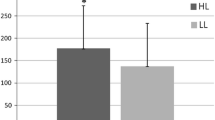Abstract
The purpose of this study is to investigate the effects of a traditional strengthening program on subjects' maximum acceptable lifting load. Nineteen (nine males, ten females) university students volunteered for the present study. They were randomly divided into a training group (five males, seven females) and a control group (four males, three females). The training group participated in 12 sessions of alternate day traditional dead weight strengthening programs for a period of 4 weeks. The measurements of the training effects included assessment of the maximum acceptable lifting load by psychophysical approach and isokinetic peak torque of the back extensors, knee extensors, shoulder abductors, and elbow flexors. Multivariate ANOVA was used to test for the training effect. Results revealed significant improvement in the maximum acceptable lifting load (p < 0.001) and back extensors peak torque (p = 0.039) after 4 weeks of training. It is concluded that a 4-week free weight muscle training program is effective in improving an individual's maximum acceptable lifting load. This type of physical training program may be useful to people engaged in manual material handling tasks.
Similar content being viewed by others
REFERENCES
Victoria Department of Labour. Occupational Health and Safety (Manual Handling) Regulations and Code of Practice. Australia: Department of Labour, 1988.
Ayoub MM. Modelling in manual material handling. Proceedings of the 29th Annual Conference of the Ergonomics Society of Australia, 1993; pp. 47-55.
Klein BP, Jensen RC, Sanderson LM. Assessment of workers' compensation claims for back strain/sprains. J Occup Med 1984; 26(6): 443-448.
Garg A. Epidemiological basis for manual lifting guidelines. NIOSH Purchase Order Report 937284, DHHS, NIOSH, Cincinnati, OH, 1989; pp. 31-40.
Chaffin DB, Park KS. A longitudinal study of low back pain as associated with occupational weight lifting factors. Am Ind Hyg Assoc J 1973; 34: 513-525.
Poulsen E, Jorgensen K. Back muscle strength, lifting, and stooped working postures. Appl Ergon 1971; 2(3): 133-137.
Magora A. Investigation of the relation between low back pain and occupation. 6. Medical history and symptoms. Scand J Rehab Med 1974; 6: 81-88.
Poulsen E. Back muscle strength and weight limits in lifting. Spine 1981; 6(1): 73-75.
Asfour SS, Ayoub MM, Mital A. Effects of an endurance and strength training programme on the lifting capability of males. Ergonomics 1984; 27: 435-442.
Genaidy AM. Truncal flexibility exercise effects on musculoskeletal capability for manual handling operations. Appl Ergon 1991; 22(3): 155-162.
Genaidy AM. A training programme to improve human physical capability for manual handling jobs. Ergonomics 1991; 34: 1-11.
Sharp MA, Legg SJ. Effects of psychophysical lifting training on maximal repetitive capacity. Am Ind Hyg Assoc J 1988; 49: 639-644.
Genaidy A, Davis N, Delgado E, Garcia S, AL-Herzalla E. Effects of a job-simulated exercise programme on employees performing manual handling operations. Ergonomics 1994; 37: 95-106.
Bentsen H, Lindgärde F, Manthorpe R. The effect of dynamic strength back exercise and/or a home training program in 57-year-old women with chronic back pain—Results of a prospective randomized study with a 3-year follow-up period. Spine 1997; 22(5): 1494-1500.
Ayoub MM, Mital A. Manual materials handling. Taylor & Francis, 1989, p. 116.
Albert M, Lathrop J. Free weight training. In: Albert M, ed. Eccentric muscle training in sports and orthopaedics. 2nd Ed. Churchill Livingstone, 1995, p. 159.
Bendix AF, Bendix T, Labriola M, Békgarrd P. Functional restoration for chronic low back pain: Two-year follow-up of two randomized clinical trials. Spine 1998; 23(6): 717-725.
Johannsen F, Remvig L, Kryger P, Beck P, Warming S, Lybeck K, Dreyer V, Larsen LH. Exercises for chronic low back pain: A clinical trial. J Orthop Sports Phys Ther 1995; 22: 52-59.
Sachs BL, David JA, Olimpio D, Scala AD, Lacroix M. Spinal rehabilitation by work tolerance based on objective capacity assessment of dysfunction. A prospective study with control subjects and twelve-month review. Spine 1990; 15(12): 1325-1332.
Hupli M, Hurri H, Luoto S, Risteli L, Vanharanta H, Risteli J. Low synthesis rate of type I procollagen is normalized during active back rehabilitation. Spine 1997; 22(8): 850-854.
Author information
Authors and Affiliations
Corresponding author
Rights and permissions
About this article
Cite this article
Yeung, S.S., Chan, M.C., Leung, D.C. et al. The Effects of a Four-Week Muscle Strengthening Program on Maximum Acceptable Lifting Load. J Occup Rehabil 8, 265–272 (1998). https://doi.org/10.1023/A:1023077702479
Issue Date:
DOI: https://doi.org/10.1023/A:1023077702479




